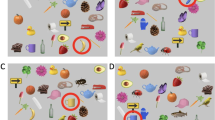Abstract
We investigated effects of element features on statistical description of relative frequency. In Experiment 1, we manipulated the proportion of two elements types forming a set and the set size and measured response time and the accuracy of relative numerosity discrimination. We did this with element pairs that had been shown to produce search symmetries or asymmetries in visual search task. We found that pop-out elements in the search asymmetry pair were numerically overestimated. In Experiment 2, we used sets of circles and circles with gaps to eliminate the possibility that the overestimation found in Experiment 1 was due to larger contour length of pop-out elements. In Experiment 3, we manipulated proportion of two elements types and the set size to measure point of subjective equality (PSE) and the slopes of z-score functions in relative numerosity discrimination to support the results of Experiments 1 and 2. The results generally showed that the proportion of pop-out elements is likely to be overestimated and that set size had no effect, suggesting that the types of features characterized by visual search could influence the accuracy and precision in discrimination of relative numerosity.





Similar content being viewed by others
References
Allik, J., Tuulmets, T., & Vos, P. G. (1991). Size invariance in visual number discrimination. Psychological Research, 53, 290–295.
Averbach, E. (1963). The span of apprehension as a function of exposure duration. Journal of Verbal Learning and Verbal Behavior, 2, 60–64.
Barth, H., Kanwisher, N., & Spelke, E. (2003). The construction of large number representations in adults. Cognition, 86, 201–221.
Beck, D. M., & Kastner, S. (2005). Stimulus context modulates competition in human extrastriate cortex. Nature Neuroscience, 8, 1110–1116.
Burgess, A., & Barlow, B. H. (1983). The precision of numerosity discrimination in arrays of random dots. Vision Research, 23, 811–820.
Cantlon, J. F., & Brannon, E. M. (2006). Shared system for ordering small and large numbers in monkeys and humans. Psychological Science, 17, 401–406.
Chong, S. C., & Treisman, A. (2004). Attentional spread in the statistical processing of visual displays. Perception & Psychophysics, 66, 1282–1294.
Dehaene, S. (1997). The Number Sense: How the mind creates mathematics. New York: Oxford University Press.
Dehaene, S., Dupoux, E., & Mehler, J. (1990). Is numerical comparison digital? Analogical and symbolic effects in two-digit number comparison. Journal of Experimental Psychology: Human Perception and Performance, 16, 626–641.
Durgin, F. H. (1995). Texture density adaptation and the perceived numerosity and distribution of texture. Journal of Experimental Psychology: Human Perception and Performance, 149, 149–169.
Hollands, J. G., & Spence, L. (2001). The discrimination of graphical elements. Applied Cognitive Psychology, 15, 413–431.
Hurewitz, F., Gelman, R., & Schnitzer, B. (2006). Sometimes area counts more than number. Proceedings of the National Academy of Sciences of the United States of America, 103, 19599–19604.
Julesz, B. (1984). A brief outline of the texton theory of human vision. Trends in Neuroscinece, 7, 41–45.
Kadosh, R. C., Kadosh, K. C., & Henik, A. (2008). When brightness counts: The neuronal correlate of mumerical–luminance interference. Cerebral Cortex, 18, 337–343.
Moyer, R. S., & Landauer, T. K. (1967). Time required for judgments of numerical inequality. Nature, 215, 1519–1520.
Nothdurft, H. C. (1993). The role of features in preattentive vision: Comparison of orientation, motion and color cues. Vision Research, 33, 1937–1958.
Reynolds, J. H., & Desmone, R. (2003). Interacting roles of attention and visual salience in V4. Neuron, 37, 853–863.
Ross, J. (2003). Visual discrimination of number without counting. Perception, 32, 867–870.
Rubenstein, B. S., & Sagi, D. (1990). Spatial variability as a liming factor in texture-discrimination tasks: Implications for performance asymmetries. Journal of Optical Society of America, 7, 1632–1643.
Shuford, E. M. (1961). Percentage estimation of proportion as a function of element type, exposure time, and task. Journal of Experimental Psychology, 61, 430–436.
Treisman, A. (2006). How the deployment of attention determines what we see. Visual Cognition, 14, 411–443.
Treisman, A., & Gelade, G. (1980). A feature integration theory of attention. Cognitive Psychology, 12, 97–136.
Treisman, A., & Gormican, S. (1988). Feature analysis in early vision: Evidence for search asymmetries. Psychological Review, 95, 15–48.
Treisman, A., & Souther, J. (1985). Search asymmetry: A diagnostic for preattentive processing of separable features. Journal of Experimental Psychology: General, 114, 285–310.
Trick, L. M., & Pylyshyn, Z. W. (1993). What enumeration studies can show us about spatial attention: Evidence for limited capacity preattentive processing. Journal of Experimental Psychology: Human Perception and Performance, 19, 231–351.
Trick, L. M., & Pylyshyn, Z. W. (1994). Why are small and large numbers enumerated differently? A limited-capacity preattentive stage in vision. Psychological Review, 101, 80–102.
Varey, C. A., Mellers, B. A., & Birnbaum, M. H. (1990). Judgments of proportion. Journal of Experimental Psychology: Human Perception and Performance, 16, 613–625.
Wolfe, J. M. (1998). What do 1,000,000 trials tell us about visual search? Psychological Science, 9, 33–39.
Wolfe, J. M. (2001). Asymmetries in visual search: An introduction. Perception & Psychophysics, 63, 381–389.
Author information
Authors and Affiliations
Corresponding author
Rights and permissions
About this article
Cite this article
Tokita, M., Ishiguchi, A. Effects of element features on discrimination of relative numerosity: comparison of search symmetry and asymmetry pairs. Psychological Research 74, 99–109 (2010). https://doi.org/10.1007/s00426-008-0183-1
Received:
Accepted:
Published:
Issue Date:
DOI: https://doi.org/10.1007/s00426-008-0183-1




